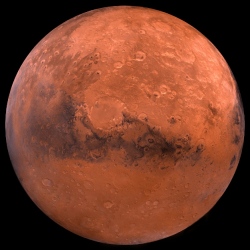
Phobos and Deimos are both small for moons, about 14 and 7.7 miles wide, respectively, and sort of potato-shaped. Compared to other moons in the solar system, they look more like asteroids. Therefore, astronomers previously thought that these moons were asteroids captured by Mars’ gravity.
But if that were the case, previous research suggested that Phobos and Deimos would have relatively irregular orbits. In reality, these moons have nearly circular orbits positioned near the Martian equator.
Another possible origin story for the Martian moons is that they coalesced from the debris of a giant impact, similar to the one largely thought to have formed Earth’s moon. This rubble would have first formed a ring around Mars, and as moons emerged from this ring, they would have ended up with similarly circular orbits. However, this possibility raises the question of why Mars would end up with two moons instead of a single moon like Earth did, according to the new research paper.
To learn more about the potential origins of Phobos and Deimos,study lead author Pascal Rosenblatt, lead author on the new study, and a planetary scientist at the Royal Observatory of Belgium in Brussels, and his colleagues investigated scenarios "left on the side until now," Rosenblatt told Space.com. "I rapidly discovered they were left not always for justified reasons."
The scientists focused on the huge impact that previous research suggested created the gigantic Borealis basin in the northern lowlands of Mars, which covers two-fifths of the Red Planet’s surface. Prior work suggested that this basin is an impact crater, created when an impactor about 1,200 miles (2,000 kilometers) wide struck Mars, generating a ring of debris around the Red Planet with a mass of about 110 quadrillion tons (100 quadrillion metric tons), or about 10,000 times the combined mass of Phobos and Deimos.
The research team’s computer models suggested that, over time, in the inner part of this debris ring where the rubble was most densely packed, large moons up to hundreds of miles in diameter would have clumped or accreted together. In contrast, in the outer part of the debris ring, dust and rocks were thinly dispersed, making it difficult for this material to accrete into moons.
However, the scientists found that gravitational tugs from one or more large moons from the inner debris ring could have stirred up rubble in the outer ring, shepherding rock and dust to form smaller outer moons, such as Phobos and Deimos. The researchers calculated that after about 5 million years, Mars’ gravitational pull would have doomed the other moons, sending them crashing to the Red Planet’s surface and leaving Phobos and Deimos as the sole survivors.
"Our results pave a new path to re-understand the Martian system in a context of formation similar but not identical to [that of] our own moon,"
